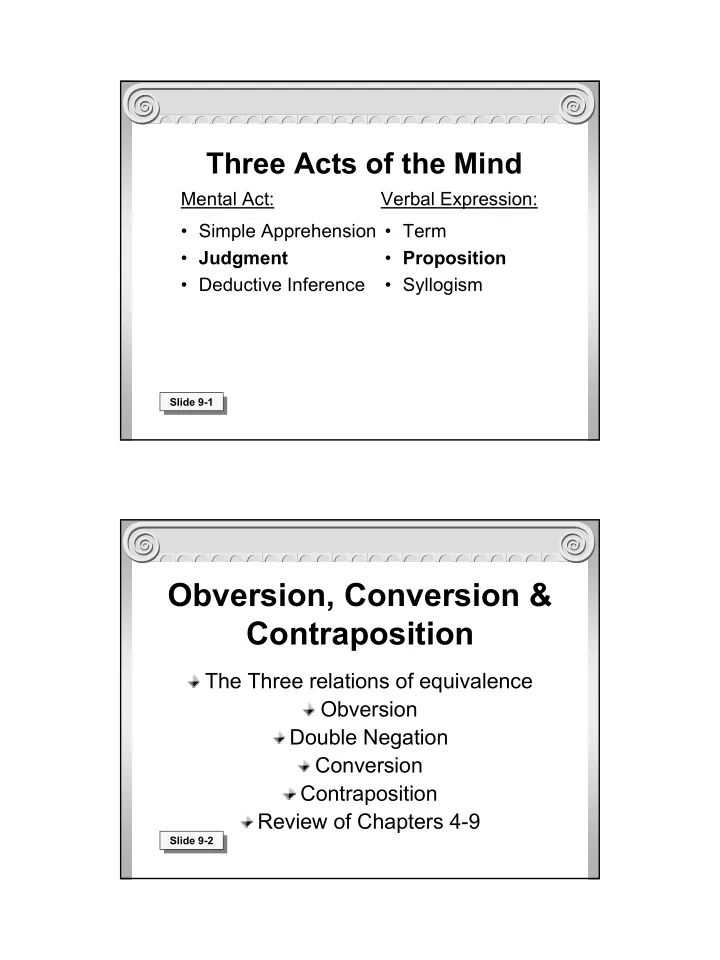

Three Acts of the Mind Mental Act: Verbal Expression: • Simple Apprehension • Term • Judgment • Proposition • Deductive Inference • Syllogism Slide 9-1 Obversion, Conversion & Contraposition The Three relations of equivalence Obversion Double Negation Conversion Contraposition Review of Chapters 4-9 Slide 9-2 1
Equivalence: Three ways to convert logical statements into their logical equivalents Obversion Conversion Contraposition Slide 9-3 Obversion Change the quality of the statement Negate the predicate Slide 9-4 2
How to change the quality of a statement If the statement is affirmative, simply make it negative If the statement is negative, simply make it affirmative Be careful not to change the quantity of the statement: A �� E, I �� O Slide 9-5 Examples of how to change the quality of a statement: All S is P � No S is P No S is P � All S Is P Some S is P � Some S is not P Some S is not P � Some S is Slide 9-6 P 3
How to change the quality of a statement Simply place a ‘not’ in front of it. Slide 9-7 How to obvert an A statement Change the quality: All S is P � No S is P Then negate the predicate: No S is P � No S is not P Slide 9-8 4
How to obvert an E statement Change the quality: No S is P � All S is P Then negate the predicate: All S is P � All S is not P Slide 9-9 How to obvert an O statement Change the quality: Some S is not P � Some S is P Then negate the predicate: Some S is P � Some S is non-P Slide 9-10 5
The Rule of Double Negation A term that is not negated is equivalent to a term that is negated twice and vice- versa. Slide 9-11 How to perform double negation 1. Place two ‘not’s at the beginning of the predicate-term 2. Make the second ‘not’ a ‘non’ and attach it to the predicate term with a dash 3. Place an ‘im’, ‘un’, ‘in’, or ‘ir’ at the beginning of the predicate term 4. Apply the rule of double negation Slide 9-12 6
How to obvert an I statement Change the quality: Some S is P � Some S is non-P Then negate the predicate: Some S is not P � Some S is not non-P Slide 9-13 Conversion Interchange the subject and predicate Slide 9-14 7
How to convert an E and I statements Interchange the subject and the predicate: No S is P � No P is S Some S is P � Some P is S Slide 9-15 Partial conversion of A statements Interchange the subject and the predicate and change the quantity : All S is P � Some S is P Slide 9-16 8
Contraposition Obvert the statement Convert the statement Obvert the statement again Slide 9-17 How to convert an A statement Original Statement : All men are mortal Obvert: No men are non-mortal Convert: No non-mortals are men Obvert: All non-mortals are non-men Slide 9-18 9
Obversion, Conversion & Contraposition Equivalents A E I O � � � � Obversion � � Conversion � � Contraposition Slide 9-19 10
Recommend
More recommend